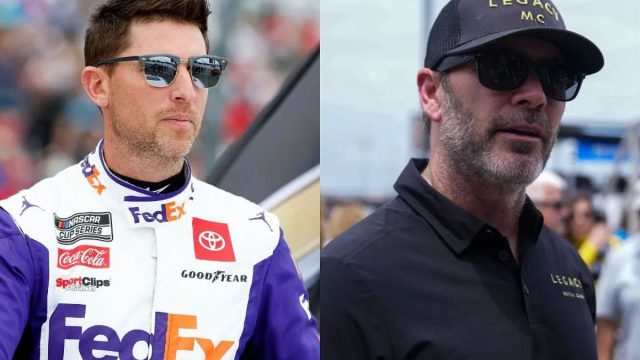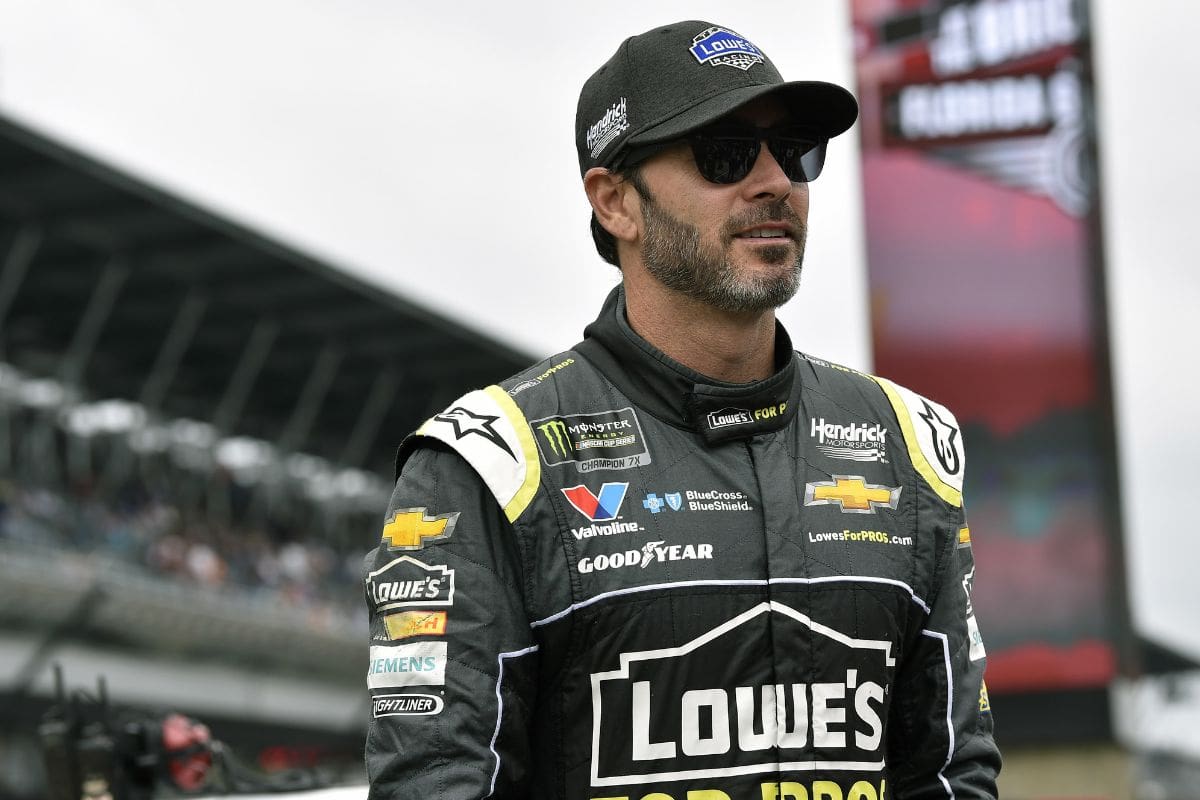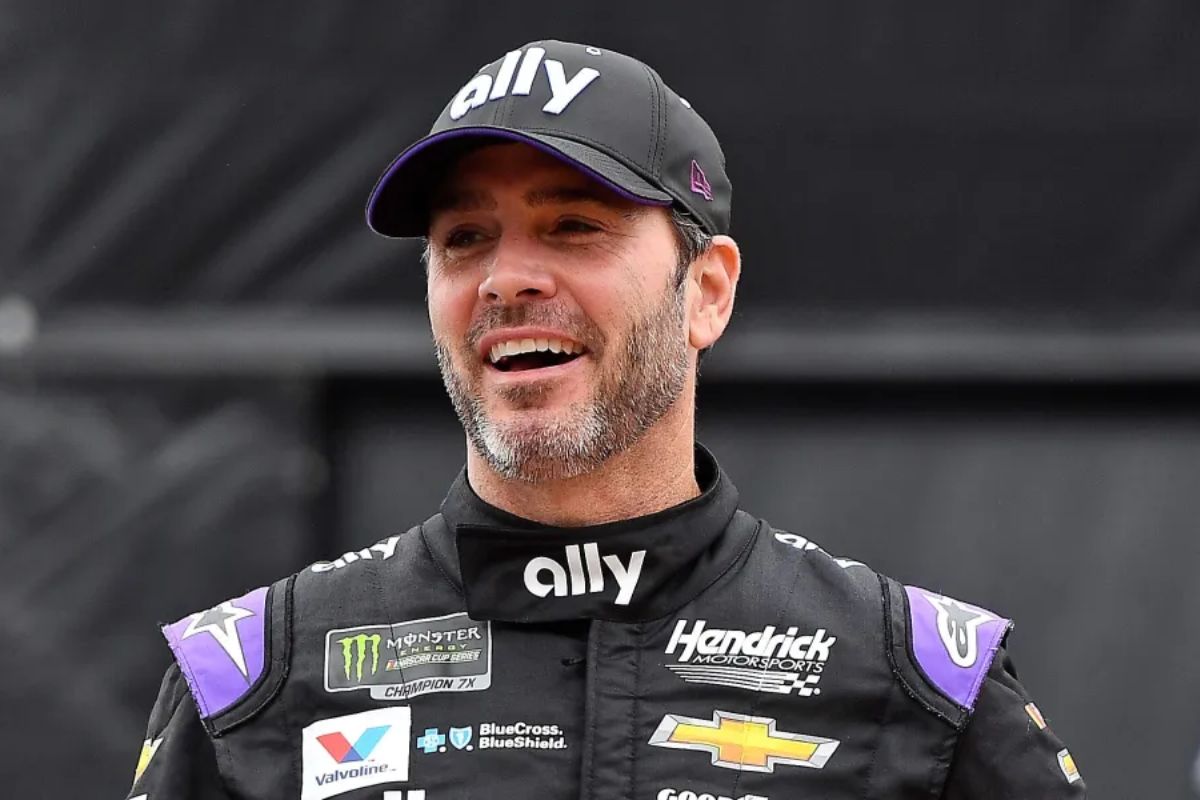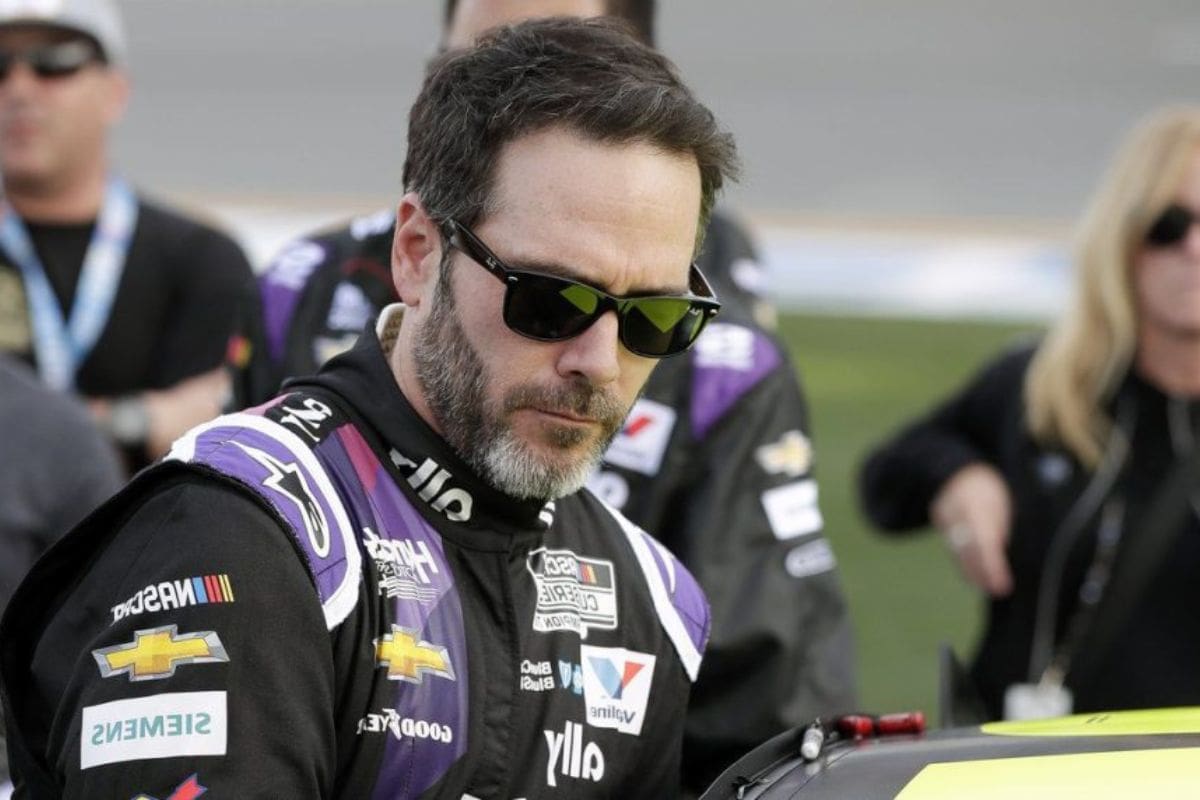Jimmie Johnson’s Bold Response: In a recent turn of events in NASCAR, Jimmie Johnson’s bold counter to Denny Hamlin’s claim about the aerodynamics of the Next Gen race car has stirred the pot in the racing community. Johnson, leveraging his extensive experience and sophisticated understanding of race dynamics, challenges Hamlin’s perspective with a well-founded argument that highlights his mastery of the sport. This confrontation not only emphasizes the ongoing debate about the technical evolutions within NASCAR but also sets the stage for a detailed discussion on how veteran insights might influence the adaptation of racing strategies in the Next Gen era.
Key Takeaways
- Jimmie Johnson challenges Denny Hamlin’s views on aero-blocking techniques in NASCAR.
- Johnson emphasizes the adaptability needed with the Next Gen car’s aerodynamics.
- He asserts the importance of strategic driving and technological mastery.
- Johnson highlights his focus on improving performance at mile-and-a-half tracks.
Jimmie Johnson’s Return to the Racetrack
Despite his impressive track record, Jimmie Johnson faced significant challenges during his much-anticipated return to the racetrack, particularly at the Monster Mile where he previously claimed 11 Cup victories. Johnson’s shift to the No. 84 Toyota Camry, especially after previous races at Daytona and Texas with the Next Gen car, did not manifest the dominance many expected based on his historical performances at Dover. This change highlights the complexities and evolving nature of NASCAR racing, where past successes do not necessarily predict future results, especially with the introduction of new technologies and car models.
Analyzing Johnson’s P28 finish, several factors come into play. The Next Gen car, a significant departure from the vehicles Johnson drove during his peak years, features numerous technological and engineering advancements. These changes require drivers to adapt their techniques and strategies. Johnson’s results suggest a learning curve that even seasoned veterans must navigate when dealing with innovative racing technologies.
Aero-Blocking Techniques in NASCAR
While Jimmie Johnson’s return to the racetrack highlighted challenges with adapting to new technologies, another evolving aspect of NASCAR highlighted during the recent races involves the strategic use of aero-blocking techniques. This method, where drivers manipulate airflow around their vehicles to hinder the progress of competitors directly behind them, has become a focal point of both strategy and controversy.
Denny Hamlin, a seasoned driver, defends aero-blocking as a longstanding element intrinsic to racing. His perspective emphasizes the importance of such techniques in competitive racing environments where maintaining a lead can hinge on effective use of the car’s aerodynamic properties. He argues that blocking is a crucial skill that complements technical driving ability and situational awareness.
“It’s been around forever and you’re not gonna change it.”-hamlin
Contrastingly, Jimmie Johnson, along with drivers like Kyle Larson and Kyle Busch, seems to challenge this view, possibly advocating for a purer form of racing where such tactics are minimized.
Analyzing this from an aerodynamic standpoint, aero-blocking involves creating turbulent air behind the lead car, reducing the following car’s ability to gain speed and overtake. This not only requires precise vehicle control at high speeds but also an intimate understanding of how air flow affects car performance under varying conditions.
Aero Advantage of the Next Gen Race Car
The Next Gen race car introduces a noteworthy aerodynamic advantage by increasing downforce, improving cornering capabilities while impacting the dynamics of airflow for trailing vehicles. This transformation in the aerodynamic profile of NASCAR’s Next Gen race car not only revolutionizes how the cars handle but also strategically alters the competitive landscape.
Great explanation here from @JimmieJohnson on the air effects of NextGen.
The Dover 🐐 on what he was expecting versus what happened…
(h/t @BrandonKettelle) pic.twitter.com/LqofFSA5DZ
— Alan Cavanna (@AlanCavanna) April 30, 2024
- Increased Downforce: The Next Gen car features modifications that greatly amplify downforce. This force presses the car onto the track, particularly in the corners, allowing for greater speed and stability during high-speed maneuvers. The increased downforce reduces slip and tire wear, providing a more consistent performance throughout the race.
- Improved Cornering Capabilities: With the augmentation in downforce, drivers experience enhanced grip during cornering. This capability allows for sharper turns at higher speeds without losing control, which is important in overtaking maneuvers and maintaining lap consistency.
- Airflow Management: The redesigned body of the Next Gen car includes features that efficiently manage the airflow, directing it in a manner that optimizes aerodynamic efficiency. This management not only benefits the lead car but also strategically influences the aerodynamics for trailing cars, creating tactical depth in races.
Johnson’s Struggles with Aero Blocks
Building on the aerodynamic advantages of the Next Gen race car, Jimmie Johnson’s experiences with aero blocks highlight the intricate challenges drivers face with this new technology in competitive scenarios. Johnson’s struggles with aero blocks at Dover exemplify a broader issue where the aerodynamics of the Next Gen car fundamentally alter the dynamics of racing.
“First time on track, there are a few moments trying to get by 99. I was hopeful that I could get close to him in the center of the corner and kind of wedge him up out of the way, get some air in there to move him, and I didn’t get in his a**.”-johnson
Unlike the Gen 6 car, where Johnson felt he could navigate more assertively and effectively displace competitors like Daniel Suarez, the Next Gen vehicle presents a stark contrast in handling and tactical execution.
“Like I was close enough with the previous generations cars that would have done something, and it didn’t do anything. Then he would cut the stream off at the second apex, and I was behind him; it was just a loss of downforce, pretty balanced, just lost all four and used up more road than I expected.”-johnson
Johnson’s detailed recount of his attempts to pass Suarez reveals the subtle interplay of aerodynamics in racing. He anticipated leveraging the center of the corner to wedge Suarez upwards, thereby gaining a positional advantage. However, the aero block executed by Suarez – cutting off the airflow at the subsequent apex – left Johnson grappling with a significant loss of downforce. This aerodynamic interference caused his car to lose all four tires’ grip simultaneously, forcing him to use more of the road than anticipated and ultimately undermining his race strategy.
Johnson’s Focus on Mile-and-Half Races
Focusing on mile-and-half races, Jimmie Johnson and Legacy Motor Club have strategically chosen this subset of events to optimize their performance with the Next Gen car. This decision is rooted in a combination of Johnson’s historical expertise on these tracks and the distinct characteristics of the Next Gen car, which demands an intricate balance of speed, aerodynamics, and tire management. The targeted approach allows Johnson to capitalize on his strengths while adapting to the new dynamics of the car.
“It’s part of the plan to make sure that I can get reps on similar tracks. I know Dover is an outlier but again it falls in a great rhythm. I think Dover in the past surprisingly car set up wise always applied to Charlotte. I’m running 600 later this year. Running both Kansas events was intentional so that I continue to build reps and help my own advancement along with technology for the race team as well.”-johnson
- Consistency in Track Characteristics: Mile-and-half tracks provide a relatively uniform challenge in terms of track layout and surface, which can help in fine-tuning the car setup and driving strategy specific to this kind of race environment.
- Strategic Race Selection: Johnson plans to participate in nine races this season, including key mile-and-half tracks such as Kansas Speedway and Charlotte Motor Speedway. This selective approach allows for concentrated preparation and potentially optimizes performance outcomes.
- Technological Adaptation: Each race provides valuable data and experience, aiding Johnson and his team in understanding and leveraging the Next Gen car’s capabilities. Focusing on similar tracks improves the team’s ability to make precise adjustments and improvements.
News in Brief: Jimmie Johnson’s Bold Response
Jimmie Johnson’s strategic reevaluation for his return to NASCAR highlights a profound understanding of the sport’s evolving technical demands. His adeptness at confronting aero-blocking challenges, especially with the Next Gen car, emphasizes a deep commitment to mastering aerodynamic complexities.
Focusing on optimizing performance in mile-and-half races, Johnson exemplifies a meticulous approach to leveraging the aero advantages inherent in modern racecar design, positioning himself as a resilient and inventive contender in the field.
Our Reader’s Queries
Q. How did Jimmie Johnson get into racing?
A. Johnson’s illustrious career commenced at the age of 5, racing motorcycles. By 8, he clinched the 60cc class championship, showcasing his early prowess. With a penchant for anything on wheels, Johnson also ventured into the off-road series.
Q. Is Jimmy Johnson a NASCAR driver?
A. Jimmie Kenneth Johnson, born on September 17, 1975, is an American professional auto racing driver. He currently participates part-time in the NASCAR Cup Series, steering the No.
Q. Why did Jimmie Johnson go back to NASCAR?
A. After encountering challenges during his two-year stint in IndyCar, Johnson found satisfaction in the series before a business venture lured him back to NASCAR. This opportunity involved an ownership share in what is presently recognized as the Legacy Motor Club, alongside Maury Gallagher, Chairman, and CEO of Allegiant Airlines.
Q. Does Jimmie Johnson own a race team?
A. By the conclusion of the 2022 season, NASCAR Cup Series outfit LEGACY MOTOR CLUB revealed that Johnson had entered into an ownership pact with Maurice “Maury” Gallagher, alongside the team’s original founder and namesake, Richard “The King” Petty.
ALSO READ: Jimmie Johnson’s Electric Evolution: Revolutionary Step



